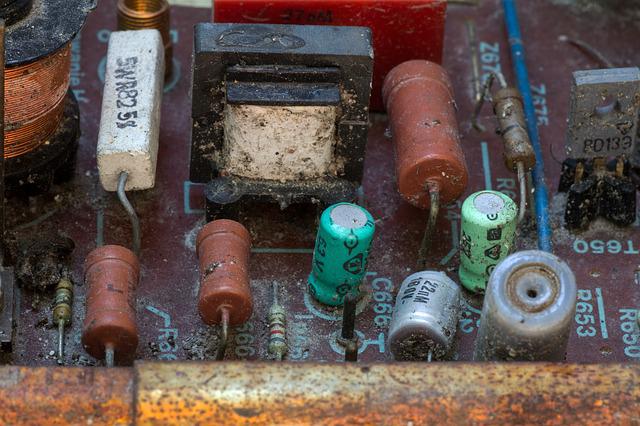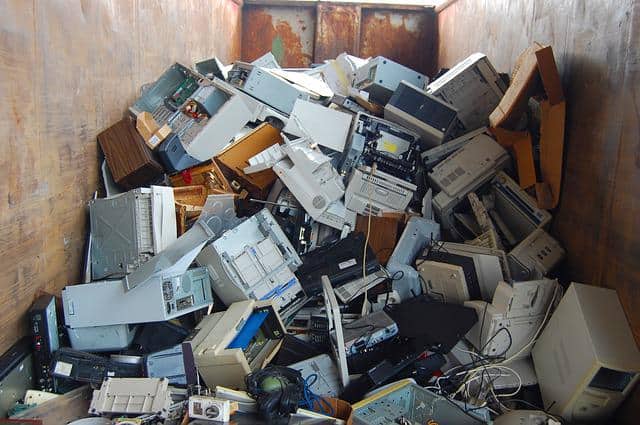Electronic Waste – Climate Problem Borne From Excess Electronic Equipment
Carbon reduction often goes hand-in-hand with reducing pollutants. Although pollutants don’t contribute to global warming, they certainly contribute to poor health. Among the growing pollutant problems is e-waste. E-waste is a term used to describe no longer wanted or needed electronic equipment. This includes old computers and TVs to cell phones and digital cameras.
E-Waste Comprises Undesirable Waste Metals
E-waste inherently contributes to two types of problems. First it contains harmful metals such as Cadmium, tellurium, gallium, mercury, and arsenic that can pollute the environment and cause health problems for people exposed to it. Second, readers of this site would understand is that e-waste is produced from energy intensive processes which contribute to carbon emissions.
E-Waste Reached 3.4 Million Tons In 2012
The most surprising of all the e-waste facts is that the United States generates the most e-waste globally. In 2012, the US generated over 3.4 million tons of e-waste. That’s more than any other country in the world! If you have e-waste that you need to get rid of, it’s important to find a safe and responsible way to do it. Otherwise, you could be contributing to the growing problem of e-waste pollution.
We should know about e-waste facts so we as to understand what to support in order to mitigate or prevent the problem.

E-waste Facts To Highlight The Scope Of The Challenge
E-waste is a growing problem globally. It is estimated that only 15% of e-waste is properly recycled, while the remaining 85% ends up in landfills where it can leach harmful chemicals into the ground and water supply.
There are a few ways to dispose of e-waste safely. One option is to recycle it. This means you will use the materials in the e-waste to make new products. Another option is to donate it to organizations that can reuse or refurbish the equipment.
Here are 10 E-waste facts that you should know:
1. The US is the largest producer of e-waste in the world. In 2012, the US generated over 3.4 million tons of e-waste. This is no surprise as Americans not only invented the solid state transistor which is at the heart of all modern electronics, but also form the largest economy in the world that relies on powerful computing equipment for business and research.
2. Most e-waste ends up in landfills where it can leach harmful chemicals into the ground and water supply. Over time, e-waste decays into waste carbon emissions.
3. E-waste contains various harmful chemicals, including lead, mercury, and cadmium. These chemicals are associated with various health problems, including cancer, brain damage, and reproductive problems.
4. Some companies offer take-back programs for their products at the end of their lifespan. Apple, for example, has a recycling program for its iPhones, iPads, laptops, and even chargers. The drawback is that the customer brings in the products to the stores.
5. Only 15% of e-waste is properly recycled. The remaining 85% ends up in landfills or is incinerated. Many countries have enacted laws to prohibit the dumping of e-waste in landfills. However, these laws are often not enforced.
6. Outdated television sets and CRT monitors contain approximately 4-8 pounds of lead, a neurotoxin. If not disposed of properly, this toxic substance can leach into the ground and cause neurological problems. Children are recommended to be tested for lead annually.
7. E-waste recycling creates jobs. It is estimated that for every 1 million tons of e-waste recycled, 7,000 jobs are created. Recycling not only recaptures the metals used but also in the same vein eliminates carbon emissions from manufacture and disposal.
8. There are various ways to recycle e-waste, including donating it to organizations that can reuse or refurbish the equipment. You can also reduce your contribution to e-waste by buying products that are made to last longer and avoiding unnecessary upgrades.
9. The value of the raw materials utilized in e-waste manufactured in the United States during 2019 was $7.49 billion. That’s correct. We threw billions of dollars worth of resources away that could be reused. Recycling e-waste can help recover valuable metals, such as gold and silver. There are DIY guides for recovering the precious metals. However, we don’t recommend using them to make money because you will spend more money and make money from these processes.
10. Not all e-waste recycles are created equal. Some recycle safely, while others export the waste to developing countries, which does more harm than good. Businesses in developing countries often have residents disassemble scrap electronics for metal rather than recycle them, exposing the workers to toxic materials.
E-waste doesn’t have to mean environmental disaster. With a little knowledge and effort, we can all do our part to reduce the amount of e-waste in landfills. By recycling or donating our used electronics, we can help make a difference.
E-waste Contributes Toxins
E-waste, or electronic waste, is the growing pile of outdated, broken, and end-of-life electronics. It includes everything from defunct laptops to unused cell phones. The Environmental Protection Agency estimates that only 15-20% of e-waste is properly recycled each year, meaning that most of it ends up in landfills where it can leach toxic chemicals into the ground and water.
E-waste is a major problem because it contains various harmful materials, including lead, cadmium, and mercury. These toxins can cause serious health problems if they enter the food chain. For example, lead can damage the nervous system and cause learning disabilities in children. Cadmium can damage the kidneys and lungs, while mercury can damage the brain and nervous system.
E-waste Is A Product Of Carbon-Intense Processes
In addition to these health risks, e-waste also contributes to climate change. The production of new electronics requires a lot of energy, often from burning fossil fuels. And when electronics are dumped in landfills, they release greenhouse gases like carbon dioxide and methane into the atmosphere.
Fortunately, there are ways to reduce your impact on e-waste. You can start by recycling your old electronics instead of throwing them away. You can also buy recycled or refurbished electronics instead of new ones. And you can donate your old electronics to organizations that recycle them or reuse them in other ways. Taking these steps can help protect our environment from the negative impacts of e-waste.

What We Should Do To Minimize E-waste
With the ever-growing popularity of electronic devices, it’s no surprise that e-waste is becoming a major environmental concern. Each year, millions of tons of old computers, cell phones, and other electronics are sent to landfills, where they release harmful toxins into the soil and water. What can be done to minimize this growing problem?
Consumers can take responsibility for their e-waste by recycling or donating their old devices instead of throwing them away. Manufacturers also have a role to play in minimizing e-waste by designing products that are easier to recycle and using recycled materials in their products. One example is Apple’s iPhone 6s, made with a significant amount of recycled aluminum.
Another possibility is to increase the amount of repair to extend the life of devices. Actions as simple as spending extra effort to open up rusted screws yield benefits of saving desirable components or saving the entire device.
Finally, accessories made of sustainable materials has become available more widely. Bamboo keyboards eschew plastics because bamboo is a highly sustainable grass that grows fast, absorbs carbon, and recovers after harvesting unlike trees and therefore are closer to carbon neutral.
Of course, reducing our dependence on electronic devices altogether would be the best way to reduce e-waste. However, in our increasingly digital world, that may not be realistic. We can help make a big difference in the environment by taking small steps to reduce our electronic waste.
What Producers Should Do To Minimize E-waste
One of the main solutions for reducing e-waste is extended producer responsibility (EPR). This very interesting concept requires manufacturers to take responsibility for the environmental impact of their products throughout the entire product lifecycle. This includes designing products for easy disassembly and repair, collecting and recycling used products, and providing take-back programs for consumers. By taking responsibility for their products, manufacturers can reduce the amount of e-waste that is generated. The costs naturally would be shared or passed onto consumers who will have to add an ethical element to their buying of electronics.
Wrapping Up
In conclusion, e-waste is a growing problem with serious environmental consequences. However, there are ways to reduce your impact on this problem. Recycling or donating your old electronics is a great way to help the environment. And by buying recycled or refurbished products, you can support manufacturers working to reduce e-waste. Together, we can help reduce the negative impact of e-waste on our environment. Thank you for reading! We hope this article has helped you learn more about e-waste and what you can do to reduce your impact.
You can also read:
7 Food Waste Facts That Will Change The Way You Eat
What To Do With Food Waste – 7 Ideas
Supermarket Food Waste: Impact & Solutions
Going Zero Waste: A Guide to Getting Started – 2022
